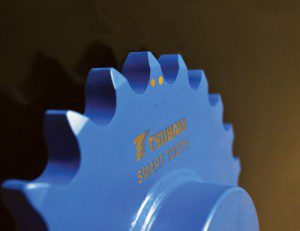Modern chains and sprockets have driven machinery for more than 100 years, but recent innovations have taken the technology into the 21st century. Recently, we asked two industry experts—Michael Hogan, senior design and applications engineer at U.S. Tsubaki’s Roller Chain Division, and Derek Glugosh, sprocket product manager at Tsubaki—for their input on what the future holds in store for the application of these essential components.
What advances have improved the performance of chains and sprockets over the last few years?
Glugosh: Our sprocket wear-indicator technology gives operators a way to see excessive wear before catastrophic failure occurs. Wear-indicator pins are strategically placed onto one or more sprocket teeth, so the resulting pressure angle of the chain roller creates wear. Blue paint on the sprockets ensure they are easy to find when inside various types of machinery. So now, as sprocket teeth wear closer to the indicator pin, users can order replacement sprockets in advance.

Hogan: We recently installed a laser-cutting machine so we can cut, bend and drill parts all in one unit. That minimizes tooling costs for plates, as we now cut from large sheets by laser instead of making tooling for blanking the plates from steel. We can also cut and machine precise holes and shapes. A flexible CNC press brake lets us make intricate bends for more complex designs, which reduces development time. There’s no wait for tooling, so we can quickly cut and adjust designs. Customers can also change designs without incurring tooling charges.
Glugosh: Consider coil-tube injectors (CTIs) in the oil and gas industry. Here, machinery uses a chain to send a tube down into an existing oil well to perform either maintenance or testing. CTIs can’t have unscheduled downtime as they’re heavy and important pieces of equipment. A typical CTI’s set of chains can cost upwards of $25,000 … therefore, if a CTI gets a new chain and gets installed on a worn sprocket that is past its usable life, it can trim chain life by as much as 50%. What’s worse, a shortened life means more downtime later.
Very few people know how to properly check for sprocket wear, so many overly worn sprockets are left in place. This is where our wear-indicator technology helps. Ultimately, it reduces overall system cost by helping engineers get maximum life from their chain and preventing unscheduled downtime.
What industries are spurring changes in the design of chain drives?
Hogan: The food industry is constantly looking for new, innovative ways to prepare and package products. Stainless steel has been the general choice for these applications; however, wear life and strength is low. Increased performance has been realized in three primary ways:
• In moderately corrosive environments where food is not in direct contact with the chain, specially coated, heat-treated chain is stronger and longer lasting than stainless-steel chain. The components are hardened carbon steel with a triple layer coating of zinc, aluminum, and a top sealant to boost resistance to red-rust oxide.
• Some stainless-steel chains contain lube-free bushing material that increases wear life and is suitable for food manufacture. These bushings avoid metal-to-metal contact between the pin and bushing and have a high resistance to wear. Direct food contact is okay.
• Custom chain parts made on our laser-cutting machine give machine engineers the ability to get more complex value-added attachments to boost product quality and production goals, often with a reduction in cost if they eliminate other machining. Engineers no longer need to design parts around what’s easiest to blank, so larger shapes, smaller holes and difficult to blank materials are possible.
Glugosh: Sprocket use doesn’t change much year over year, and it’s directly correlated to chain usage. That said, paper converting and dimensional lumber opportunities are starting to take off. With large industry potential in these two areas, sprocket demand is on the rise.
How do online tools simplify sizing and selection?
Glugosh: Manufacturer websites are excellent tools for engineers to search parts and educate themselves. Some online libraries detail roller chain and engineering-class sprockets and let visitors drill down to individual item numbers with drawings, dimensions and online-order fields. Some mobile apps have the same functions.
Hogan: When end users are designing machines with roller chains and other products, 3D is now the norm. So instead of making end users recreate part drawings, we give them CAD assemblies and components at our website. End users can even configure attachment chains to their precise spacing using an online configurator. They can even get 3D plastic models printed.
Tell us about an application where engineers used your chain components to improve their design.
Hogan: In large-scale baking of foods, chains convey product through ovens. These applications are challenged by chain wear because of continuous use at high speeds.
What’s more, traditional self-lubricating chains can’t withstand the high heat and satisfy food-grade lube requirements, and regular lubricants deteriorate at high temperatures. In contrast, new self-lubricating chains with food-grade lubrication in self-lube bushings keep working, even in ovens up to 446° F.


Leave a Reply
You must be logged in to post a comment.